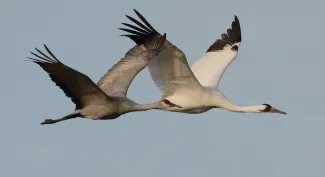
Endangered whooping cranes will often join flocks of sandhill cranes during their 2,500-mile migration. Look for the larger whooping crane's white body and black wingtips to distinguish the two species.
Each year, sportsmen, bird watchers, and other wildlife enthusiasts can join the Wildlife Department in documenting federally endangered whooping cranes as they migrate through the Great Plains. Oklahomans can help track the migration path by sharing photographs and sighting details at wildlifedepartment.com.
The 2,500-mile journey from nesting grounds in Canada to wintering grounds in coastal Texas can take nearly two months. The birds may touch down in wetlands or grain fields for a few days to rest and refuel on crustaceans, other small animals, or grain before continuing on to Texas.
The small flocks of cranes that migrate through Oklahoma are part of the only remaining naturally occurring whooping crane population, known as the Aransas-Wood Buffalo population. Last year's wintering grounds survey on and around Texas's Aransas National Wildlife Refuge estimated a record 557 whooping cranes, the first time the population has exceeded 550 individuals in many decades.
What to Look For
Whooping cranes are North America’s tallest bird, standing nearly 5 feet tall. These large, white birds have black wingtips that are seen only when in flight, and a “bustle” of feathers over the rump. They fly with their long neck and legs extended. Though most similar in shape and appearance to the more common sandhill crane, other large white birds like egrets and pelicans may be misidentified as whooping cranes. Egrets lack the height, rump bustle, red crown, and black wingtips of whooping cranes. American white pelicans have black wingtips but have an s-curved neck in flight and lack the height, rump bustle, and red crown.
In Oklahoma, whooping cranes are most often reported east of Guymon and west of Interstate 35.
